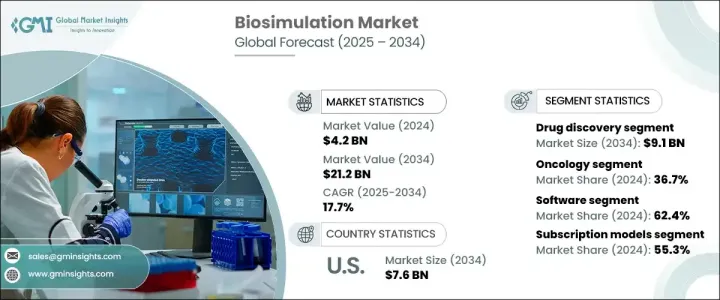
세계의 바이오시뮬레이션 시장은 2024년에 42억 달러로 평가되었으며, 2025년부터 2034년에 걸쳐 CAGR 17.7%로 성장할 것으로 예측됩니다.
컴퓨터 생물학의 최첨단 접근 방식인 바이오시뮬레이션은 고급 수학적 모델, 정교한 알고리즘, 실험 데이터를 활용하여 생물학적 시스템, 프로세스 및 상호작용을 복제합니다. 이 혁신적인 기술은 다양한 조건에서 생물학적 행동에 대한 탁월한 통찰력을 제공하여 신약 발견, 임상시험 최적화, 개인 맞춤형 의약품 개발과 같은 중요한 분야를 지원합니다.

바이오시뮬레이션은 연구자들이 복잡한 생물학적 과정을 매우 정확하게 시뮬레이션할 수 있게 함으로써 치료법을 개발, 평가 및 최적화하는 방식을 혁신하고 있습니다. 개발 비용을 절감하고 위험을 완화하며 전반적인 효율성을 향상시키는 바이오시뮬레이션의 역할은 현대 의료 혁신의 초석이 되고 있습니다. 정밀 의학에 대한 수요가 증가하고 인공 지능과 머신러닝의 채택이 증가하면서 의료 및 제약 산업에서 바이오시뮬레이션의 중요성은 더욱 커지고 있습니다.
| 시장 범위 | |
|---|---|
| 시작 연도 | 2024년 |
| 예측 연도 | 2025-2034년 |
| 시작 금액 | 42억 달러 |
| 예측 금액 | 212억 달러 |
| CAGR | 17.7% |
시장은 소프트웨어와 서비스를 포함한 제품에 따라 세분화됩니다. 2024년 소프트웨어 부문은 복잡한 생물학적 시스템을 시뮬레이션하기 위해 머신러닝과 고급 알고리즘을 활용하는 능력에 힘입어 62.4%의 점유율로 선두를 차지했습니다. 바이오시뮬레이션 소프트웨어는 통합 소프트웨어 제품군/플랫폼과 독립형 모듈의 두 가지 주요 카테고리로 제공됩니다. 이 기술은 약물 효능과 안전성에 대한 예측을 개선하여 개발 주기 초기에 유망한 약물 후보를 식별할 수 있도록 함으로써 연구자의 역량을 강화합니다. 이러한 조기 식별은 개발 프로세스를 가속화하고 관련 비용을 크게 절감하여 연구 개발 운영을 간소화하는 데 있어 바이오시뮬레이션의 가치를 강화합니다.
바이오시뮬레이션의 응용 분야는 여러 영역에 걸쳐 있으며, 2024년에는 신약 개발이 42.5%의 점유율을 차지하며 시장을 주도할 것으로 예상됩니다. 신약 개발 부문은 2034년까지 91억 달러에 달할 정도로 크게 성장할 것으로 예상됩니다. 바이오시뮬레이션은 컴퓨터 모델을 사용하여 잠재적 약물의 거동을 예측함으로써 비용이 많이 드는 후기 단계의 실패 가능성을 최소화할 수 있습니다. 연구자들은 생물학적 과정을 시뮬레이션하고 분자 설계를 개선하며 표적을 정밀하게 검증하여 치료 효능을 높이고 새로운 치료제의 출시 기간을 단축할 수 있습니다. 신약 후보물질과 생물학적 시스템 간의 복잡한 상호작용을 모델링할 수 있는 능력은 바이오시뮬레이션 시장의 판도를 바꾸며 의료 분야의 혁신적인 발전을 이끌고 있습니다.
미국은 2034년까지 76억 달러에 달할 것으로 예상되는 바이오시뮬레이션 혁신의 글로벌 리더로 자리매김할 것입니다. 최고의 연구 기관과 대학을 갖춘 미국의 탄탄한 생태계는 계산 생물학 및 바이오시뮬레이션의 발전을 뒷받침하고 있습니다. 맞춤형 치료법을 개발하기 위해 바이오시뮬레이션에 크게 의존하는 정밀 의학의 광범위한 채택은 시장 성장을 더욱 촉진하고 있습니다. 유전자 프로필에 기반한 개인 맞춤형 치료에 대한 관심은 첨단 바이오시뮬레이션 도구에 대한 지속적인 수요를 보장하며 임상 및 연구 응용 분야의 선구적인 발전에 있어 미국의 역할을 강화합니다.
The Global Biosimulation Market reached USD 4.2 billion in 2024 and is projected to grow at an impressive CAGR of 17.7% between 2025 and 2034. Biosimulation, a cutting-edge approach in computational biology, leverages advanced mathematical models, sophisticated algorithms, and experimental data to replicate biological systems, processes, and interactions. This innovative technology delivers unparalleled insights into biological behavior under diverse conditions, supporting critical sectors such as drug discovery, clinical trial optimization, and personalized medicine development.

By enabling researchers to simulate complex biological processes with exceptional accuracy, biosimulation is transforming how therapies are developed, assessed, and optimized. Its role in reducing development costs, mitigating risks, and enhancing overall efficiency makes it a cornerstone of modern healthcare innovation. The growing demand for precision medicine and the increasing adoption of artificial intelligence and machine learning further amplify the significance of biosimulation in the healthcare and pharmaceutical industries.
| Market Scope | |
|---|---|
| Start Year | 2024 |
| Forecast Year | 2025-2034 |
| Start Value | $4.2 Billion |
| Forecast Value | $21.2 Billion |
| CAGR | 17.7% |
The market is segmented based on offerings, including software and services. In 2024, the software segment dominated with a 62.4% share, driven by its ability to leverage machine learning and advanced algorithms for simulating intricate biological systems. Biosimulation software is available in two primary categories: integrated software suites/platforms and standalone modules. This technology empowers researchers by improving the prediction of drug efficacy and safety, enabling the identification of promising drug candidates earlier in the development cycle. This early identification accelerates the development process and significantly reduces associated costs, reinforcing the value of biosimulation in streamlining research and development operations.
Applications of biosimulation span multiple domains, with drug discovery leading the market in 2024, accounting for a 42.5% share. The drug discovery segment is anticipated to grow substantially, reaching USD 9.1 billion by 2034. Biosimulation enables the use of computational models to predict the behavior of potential drugs, minimizing the likelihood of costly late-stage failures. Researchers can simulate biological processes, refine molecular designs, and validate targets with precision, enhancing therapeutic efficacy and reducing time-to-market for new treatments. The ability to model complex interactions between drug candidates and biological systems is a game-changer, propelling the biosimulation market toward transformative advancements in healthcare.
The United States is set to remain a global leader in biosimulation innovation, with its market projected to reach USD 7.6 billion by 2034. The country's robust ecosystem, featuring premier research institutions and universities, underpins advancements in computational biology and biosimulation. The widespread adoption of precision medicine, which relies heavily on biosimulation to develop tailored therapies, further fuels market growth. The focus on personalized treatments based on genetic profiles ensures sustained demand for advanced biosimulation tools, strengthening the role of the U.S. in pioneering advancements across clinical and research applications.